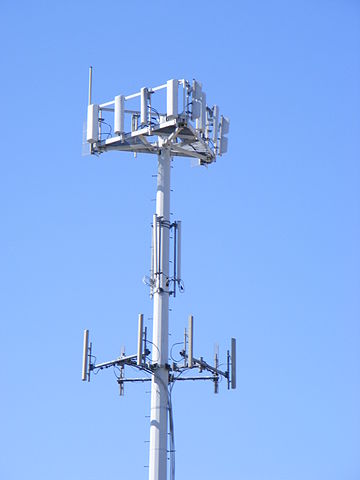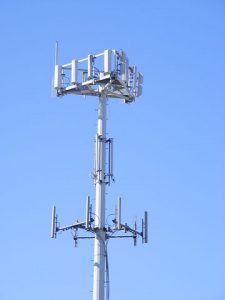It didn’t take buyers of the new iPad long to discover an unpleasant reality about their new toys. The iPad, with its fast LTE data connection high resolution display, can devour data faster than wireless carriers want to supply it. It you watch a lot of video, your monthly allocation of 2 to 4 gigabytes of data will be used in days, and you’ll be running up bills at the rate of $10 a gig (on AT&T or Verizon in the U.S.)
Wi-Fi and cellular-type services are, of course, both wireless, but there are some critical differences between them. Cellular service operate on specific frequencies assigned to carriers by the government; Wi-Fi is a free-for-all in a couple chunks of spectrum left free for unlicensed use. Cell services use expensive base stations and antennas on towers that cover anywhere from several city blocks to many square miles, depending largely on antenna height; Wi-Fi uses inexpensive access points put most anywhere, with a normal top range of 100 meters. handsets and other devices automatically authenticate themselves to cellular networks, which grant access to subscribers; Wi-Fi either requires external software authentication or is completely open to all comers.
The trick to greatly expanding capacity, especially in areas of maximum use, is to turn Wi-Fi’s weaknesses into strengths. Physically small, low-cost, short-range access points, for example, mean that the same spectrum can be used over and over again even in a relatively confined space (and reuse can be increased with careful placement of access points, turning down the transmit power, and use of directional antennas.)
Devices equipped to use both Wi-Fi and cellular networks are designed to favor Wi-Fi when it is available. But the switching to public Wi-Fi networks is far from seamless and often requires some level of human intervention.
Carriers are increasingly interested in moving traffic from their cellular networks to Wi-Fi but they want to limit access to subscribers. Wi-Fi is relatively cheap, but it’s not free, with one of the biggest costs being the “backhaul” connecting access points to the network via landlines. There currently are two ways to authenticate users. Wi-Fi Protected Access requires a password. It’s simple and lets devices connect automatically after the first time, but distributing the network identifiers (SSIDs) and passwords is difficult, and there is nothing to stop a subscriber from sharing the password with non-subscribers. 802.1x authentication requires a user name and a password, which typically must be entered in a login screen. (The use of 802.1x, which is sometimes used to provide encryption on otherwise open networks, requires a login even if that merely means opening a web page and agreeing to the terms and conditions.)
Enter 802.11u, the latest item in the IEEE’s standard 802 alphabet soup collection. 802.11u, also known as Hotspot 2.0 or Passpoint, is a standard for linking Wi-Fi hotspots to cell networks. A your mobile devices will sense the presence of a Hotspot 2.0 access point and connect to it automatically. The access point will verify the device’s subscription status, most likely using the SIM card present in many phones, and will exchange cryptographic keys so that all traffic between the device and the access point is encrypted (a major weakness in today’s open networks.)
Niels Jonker, chief technology officer for W-Fi hotspot operator and aggregator Boingo, says he expects to see Hotspot 2.0 access points begin to make their appearance early next year. Jonker says sports stadiums are logical places for early deployment. Cellular data networks sag under the strain of tens of thousands of fans texting, tweeting, and, especially, sending pictures all at once. And the reinforced concrete construction of stadiums makes it relatively easy to create small hotspots, allowing for high reuse of spectrum. Device-dense urban centers, such as the Times Square area of Manhattan, are a likely next step, along with airports.
In effect, Hotspot 2.0 will turn these hotspots into extensions of carrier networks. That can be a win for both the carriers, who ease the pressure on their cellular networks, and customers, who get fast wireless outside (unless the carriers really screw this up) increasingly restrictive data caps.


what is wifi maximum range in km
I really like reading through a post that can make men and women think. Also, thank you for allowing me to comment!
I really like reading through a post that can make men and women think. Also, thank you for allowing me to comment!
colibrim.com
Thanks for the guidelines shared on your blog. Another thing I would like to mention is that weight reduction is not information about going on a celebrity diet and trying to reduce as much weight as possible in a few months. The most effective way in losing weight is by taking it bit by bit and using some basic ideas which can provide help to make the most from your attempt to shed pounds. You may realize and be following these tips, however reinforcing understanding never does any damage.
Thanks for your submission. I also believe that laptop computers have become more and more popular nowadays, and now will often be the only kind of computer included in a household. The reason is that at the same time that they are becoming more and more cost-effective, their working power keeps growing to the point where there’re as robust as desktop computers from just a few years ago.